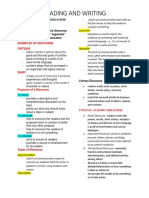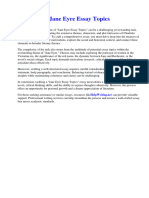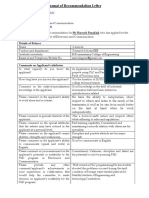Eapp Reviewer
Eapp Reviewer
Uploaded by
As AsCopyright:
Available Formats
Eapp Reviewer
Eapp Reviewer
Uploaded by
As AsOriginal Title
Copyright
Available Formats
Share this document
Did you find this document useful?
Is this content inappropriate?
Copyright:
Available Formats
Eapp Reviewer
Eapp Reviewer
Uploaded by
As AsCopyright:
Available Formats
Nature and Characteristic of an Academic Text - LESSON 3: TECHNIQUES IN SUMMARIZING VARIETY OF ACADEMIC
TEXTS
-A reading material that provides information which include
concepts and theories that are related to the specific Webster's call a summary the "general idea in brief form
discipline.
SOMEBODY WANTED BUT SO. cause and effect relationships,
Structure
- formal and logical (Introduction, Body, Conclusion) SAAC METHOD. "State, Assign, Action, Complete."
- must be cohesive and possess a logically organized
flow of ideas 5 W's, 1 H.: who, what, when, where, why, and how.
Tone
GIVE ME THE GIST. they want a summary
- refers to the attitude conveyed in a piece of writing
- arguments of others are fairly presented and with
an appropriate narrative tone
Thesis Statement - the idea of your paper. usually located at the end of
Language
the introduction and can be one to three sentences long.
- Formal language and the third person point-of view
- Clear topic sentences enable a reader to follow your TOPIC
line of thinking without difficulty
The topic of your paper.
- Technical language appropriate to the area of study
ARGUMENT/CLAIM
may also be used
Citation Your stance or the purpose of your paper.
- Citing sources in the body of the paper and EVIDENCE
The support for your argument / claim
FEATURES OF ACADEMIC TEXT
Outline - structured plan for organizing your paper
Complex - no longer words, it is lexically more varied
Purpose - To ensure that your paper has a coherent structure and logical
vocabulary.
flow.
Formal - avoid colloquial words and expressions
REACTION PAPER - form of paper writing in which the writer expresses
Precise - Facts are given accurately and precisely. his ideas and opinions about what has been read or seen.
Objective - fewer words that emphasize on the information I. First Part
Explicit - make it clear to the reader. - Contain information of the author and the topic
Accurate - have words with narrow specific meanings. - Write down and highlight the main ideas
Hedging - make decisions about your stance on a - Use direct quotations if needed
particular subject
- Avoid personal opinion
Responsible - responsible for and must be able to provide
evidence II. Second Part
Organize - flows easily from one section to the next in a - Contain your personal thoughts
logical fashion.
- Focus on a main problem
Plan - usually takes place after research and evaluation,
according to specific purpose and plan. - Back-up your statements with sources
PURPOSES IN READING AN ACADEMIC TEXT LESSON 2: TEXT STRUCTURE - way authors organize
information in text.
To locate a main idea;
To scan for information; NARRATIVE
To identify gaps in existing studies;
CHRONOLOGICAL, PROCESS, OR SEQUENCE
Factors to Consider in Writing an Academic Text
CAUSE AND EFFECT
1. State critical questions and issues;
2. Provide facts and evidence from credible PROBLEM/SOLUTION
sources;
3. Use precise and accurate words while avoiding COMPARE AND CONTRAST
jargon; DEFINITION OR DESCRIPTION
4. Take an objective point of view;
5. List references; and,
6. Use cautious language. APPROACHES IN Literary Criticism –
Academic Language - language needed by students to do Formalist Criticism - "a unique form of human
the work in schools knowledge that needs to be examined on its own terms
Gender Criticism - how sexual identity shapes.
Social Language - set of vocabulary that allows us to
Historical Criticism - literary work upon its original reader.
communicate — regular daily conversations
Reader-Response Criticism – reader’s mind
CHARACTERISTICS OF ACADEMIC LANGUAGE Media Criticism - media bias. closely examining and
judging the media
Formal(not conversational, Objective(unbiased), and Marxist Criticism - economic and political
Impersonal. Structuralism - social, cultural and
Psychological structures
You might also like
- Eapp ReviewerDocument1 pageEapp ReviewerAs AsNo ratings yet
- Fuck g12Document21 pagesFuck g12Elizabeth BandaNo ratings yet
- Kim 12 Stem 5Document8 pagesKim 12 Stem 5SHITTY MANNo ratings yet
- Eapp Exam ReviewerDocument5 pagesEapp Exam ReviewerKent BustamanteNo ratings yet
- English For Academic and Professional PurposesDocument5 pagesEnglish For Academic and Professional PurposesMary MoralesNo ratings yet
- Enfocad RebyuwerDocument7 pagesEnfocad RebyuwerSheila Ann Mae GabayNo ratings yet
- EAPP ReviewerDocument7 pagesEAPP ReviewerNeil CapiliNo ratings yet
- Reviewer Eapp Lesson 1-8Document8 pagesReviewer Eapp Lesson 1-8Angel GarciaNo ratings yet
- Eapp ReviewerDocument2 pagesEapp ReviewerMa. Sheila CruzNo ratings yet
- EAPPReviewerDocument3 pagesEAPPReviewerNikolai NoveroNo ratings yet
- Lesson 1eappDocument2 pagesLesson 1eappMonique DanielleNo ratings yet
- 1ST QUARTER EAPP StemDocument4 pages1ST QUARTER EAPP StemDainielle Marie PascualNo ratings yet
- Academic Writing (Academic Text and Non-Academic Text)Document3 pagesAcademic Writing (Academic Text and Non-Academic Text)Aljelyne KeithNo ratings yet
- Reviewer in Eapp - October '23Document2 pagesReviewer in Eapp - October '23Andrea TartarNo ratings yet
- Eapp ReviewerDocument1 pageEapp ReviewersazhmairaNo ratings yet
- Eapp ReviewerDocument14 pagesEapp ReviewerHeaven Krysthel Bless R. SacsacNo ratings yet
- EAPPDocument3 pagesEAPPxxdontmindmeNo ratings yet
- Eapp ReviewerDocument4 pagesEapp Revieweraffordablefinds105No ratings yet
- Eapp ReviewerDocument7 pagesEapp ReviewerDeanNo ratings yet
- English ReviewerDocument4 pagesEnglish Reviewerjohnalwynm.medinaNo ratings yet
- EAPP ReviewerDocument3 pagesEAPP ReviewerJodi RempilloNo ratings yet
- EappDocument3 pagesEappkerwin OligarioNo ratings yet
- Reviewer 2 EappDocument3 pagesReviewer 2 EappinamowtoNo ratings yet
- Eapp 1st Quarter NotesDocument9 pagesEapp 1st Quarter NotesDatoon JoemarieNo ratings yet
- RW 2ND Sem Midterms ReviewerDocument8 pagesRW 2ND Sem Midterms ReviewerClouie AsilomNo ratings yet
- EAPP-Reviewer 2Document5 pagesEAPP-Reviewer 2n5ct996hgdNo ratings yet
- UntitledDocument6 pagesUntitledMa. Leiah Ericka De ChavezNo ratings yet
- 1st Quarter Eapp ReviewerDocument2 pages1st Quarter Eapp ReviewerVivien Lancin100% (1)
- Eapp Summary of Lessons For Quarter 1Document2 pagesEapp Summary of Lessons For Quarter 1Mart ZedrickNo ratings yet
- English ReviewerDocument3 pagesEnglish ReviewerLara BalangiaoNo ratings yet
- EnglishDocument56 pagesEnglishm84121798No ratings yet
- EappDocument4 pagesEappHakdogNo ratings yet
- Academic Writing HandoutsDocument6 pagesAcademic Writing HandoutsJudelyn AndanarNo ratings yet
- EAPP Notes Lesson 1 8Document13 pagesEAPP Notes Lesson 1 8dwyquishNo ratings yet
- Lesson 1 3 Eng. Acad.Document3 pagesLesson 1 3 Eng. Acad.thezimikNo ratings yet
- Academic VS Non-AcademicDocument3 pagesAcademic VS Non-AcademicFebe JamieNo ratings yet
- EAP 021 Reviewer - Q1Document2 pagesEAP 021 Reviewer - Q1daxpogi16No ratings yet
- EAPP Q-1 HandoutsDocument14 pagesEAPP Q-1 HandoutsMerry Jessica RusellNo ratings yet
- Academic English vs. General EnglishDocument3 pagesAcademic English vs. General EnglishPaulo AloroNo ratings yet
- English For Academic and Professional Purposes ReviewerDocument10 pagesEnglish For Academic and Professional Purposes ReviewerJessel TapelNo ratings yet
- EAPP ReviewerDocument7 pagesEAPP Reviewerbepaca6152No ratings yet
- English Acad 1Document7 pagesEnglish Acad 1Cheena Francesca LucianoNo ratings yet
- Academic Writing and Academic Language ReviewerDocument2 pagesAcademic Writing and Academic Language ReviewersuvachuchuNo ratings yet
- Reviewer in EappDocument4 pagesReviewer in EappTCHR KIMNo ratings yet
- English For Academic Purposes ProgramDocument15 pagesEnglish For Academic Purposes ProgramanggelungubNo ratings yet
- Eapp 2ND Quiz Reviewer LPLDocument3 pagesEapp 2ND Quiz Reviewer LPLAriaane Grace DaquioagNo ratings yet
- Reviewer in EappDocument9 pagesReviewer in EappJ Marie IloNo ratings yet
- Lesson Plan 1ST SemDocument6 pagesLesson Plan 1ST SemArianne Jane PiastroNo ratings yet
- Eapp s1q1 SGDocument4 pagesEapp s1q1 SGBrenda RamosNo ratings yet
- PART 1 - Academic Language Used From Various DisciplinesDocument2 pagesPART 1 - Academic Language Used From Various DisciplinesAngelo QuintoNo ratings yet
- Reviewer in EappDocument2 pagesReviewer in EappRochell SendaydiegoNo ratings yet
- Eapp Lecture 1Document2 pagesEapp Lecture 1juanmiguelaguaspogi09No ratings yet
- Quiz 1 & 2 Reviewer EAPPDocument4 pagesQuiz 1 & 2 Reviewer EAPPFrida Antonette JusonNo ratings yet
- EAPP-Q1 Module1 Lesson-1Document9 pagesEAPP-Q1 Module1 Lesson-1Johnpatrick CiaNo ratings yet
- EAPP Lesson 1 Academic TextDocument17 pagesEAPP Lesson 1 Academic TextJennifer DumandanNo ratings yet
- CRWT ReviewerDocument4 pagesCRWT ReviewerAlyana Katrina PaderesNo ratings yet
- EAPP ReviewerDocument5 pagesEAPP ReviewerAngel SangalangNo ratings yet
- Standard Style in RRLDocument7 pagesStandard Style in RRLKaiA.SermenoNo ratings yet
- Q3 EappDocument6 pagesQ3 EappkathreenezyanaNo ratings yet
- Final Template For Research PapersDocument12 pagesFinal Template For Research PapersAs AsNo ratings yet
- 921-Article Text-1585-1-10-20240531Document15 pages921-Article Text-1585-1-10-20240531As AsNo ratings yet
- Philo 2Document25 pagesPhilo 2As AsNo ratings yet
- Criscel's Report - EAPPDocument26 pagesCriscel's Report - EAPPAs AsNo ratings yet
- CTET Question Paper 1 2019Document56 pagesCTET Question Paper 1 2019SaurabhNo ratings yet
- What Is The Profile of The Respondents in Terms ofDocument3 pagesWhat Is The Profile of The Respondents in Terms ofNormi Anne TuazonNo ratings yet
- FeatureDocument51 pagesFeatureMary Luz ManaliliNo ratings yet
- Memoir RubricDocument2 pagesMemoir Rubricapi-242419996No ratings yet
- Jane Eyre Essay TopicsDocument7 pagesJane Eyre Essay Topicsafibyoabyfffry100% (2)
- Exam 2 Study GuideDocument19 pagesExam 2 Study GuideJohn Mureithi Njuguna100% (1)
- Portafolio B1 Task 9 To 12Document2 pagesPortafolio B1 Task 9 To 12carolita23No ratings yet
- B. Krathwohl's Taxonomy of The Affective DomainDocument16 pagesB. Krathwohl's Taxonomy of The Affective DomainReshyl HicaleNo ratings yet
- CEO Proposes, BoardDocument7 pagesCEO Proposes, BoardTor 1No ratings yet
- Annual Student Outcome Goal Plan - AttendanceDocument3 pagesAnnual Student Outcome Goal Plan - Attendanceapi-727931451100% (1)
- EAPP Reviewer 1Document2 pagesEAPP Reviewer 1abegailh303No ratings yet
- Grade7 ESP Worksheet Week1Document2 pagesGrade7 ESP Worksheet Week1Yeye Lo Cordova100% (1)
- Netsanet Ayele ThesisDocument60 pagesNetsanet Ayele ThesisDedefoNo ratings yet
- Kindergarten-DLL-MELC-Q4-Week 3 AsfDocument7 pagesKindergarten-DLL-MELC-Q4-Week 3 AsfFaye Dusayen - EsclamadoNo ratings yet
- Social, Moral, and Economic IssuesDocument7 pagesSocial, Moral, and Economic IssuesAdriyel Mislang SantiagoNo ratings yet
- Leadership Vs Management ReportDocument30 pagesLeadership Vs Management ReportRosenda Mohana100% (1)
- Reference LetterDocument2 pagesReference LetterHareesh PanakkalNo ratings yet
- IELTS Personality Vocabulary: Face The IELTS Speaking Exam With Confidence!Document3 pagesIELTS Personality Vocabulary: Face The IELTS Speaking Exam With Confidence!Khánh LinhNo ratings yet
- Cuizon - Strama - Final QuizDocument2 pagesCuizon - Strama - Final QuizRosefel Ann CuizonNo ratings yet
- Achille Mbembe Necropolitics and Drug DependentsDocument7 pagesAchille Mbembe Necropolitics and Drug DependentsEugene SalazarNo ratings yet
- MODULE 3 - Human Behavior in OrganizationsDocument51 pagesMODULE 3 - Human Behavior in OrganizationsRACHEL NAVARRONo ratings yet
- Effective Communication and Writing in English...Document16 pagesEffective Communication and Writing in English...TikTok vs AnimeNo ratings yet
- Physical Self WPS OfficeDocument44 pagesPhysical Self WPS OfficeMariane Joy TecsonNo ratings yet
- Class XI: MM: 40 Time: 2 HrsDocument4 pagesClass XI: MM: 40 Time: 2 HrsNoren KunwarNo ratings yet
- Fulbright Program: Application For Study in The United StatesDocument2 pagesFulbright Program: Application For Study in The United StatesmaymyoNo ratings yet
- Love Addiction: Definition, Etiology, Treatment: Sexual Addiction & Compulsivity January 2010Document17 pagesLove Addiction: Definition, Etiology, Treatment: Sexual Addiction & Compulsivity January 2010Andra AndruNo ratings yet
- hg11 AsDocument4 pageshg11 AsMinalyn MendozaNo ratings yet
- Soal NarativDocument17 pagesSoal NarativSnowball GlxyNo ratings yet
- MONEYBALLDocument4 pagesMONEYBALLAbishek RameshNo ratings yet
- The 90-Day Prosperity ExperimentDocument3 pagesThe 90-Day Prosperity Experimentcarl100% (1)





























































































